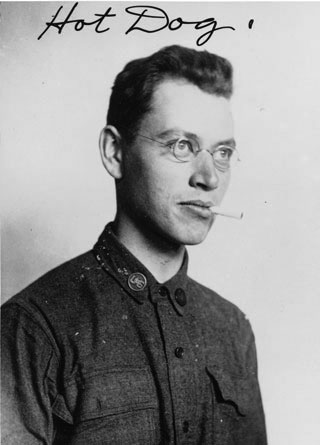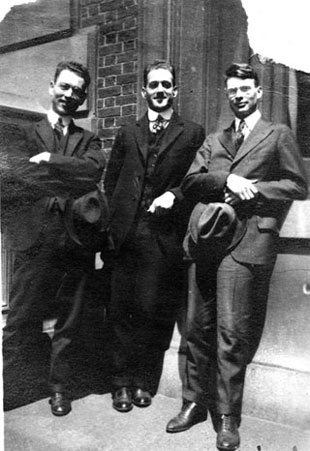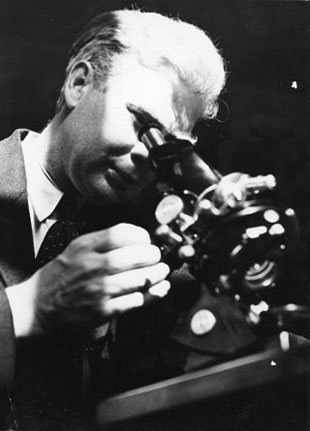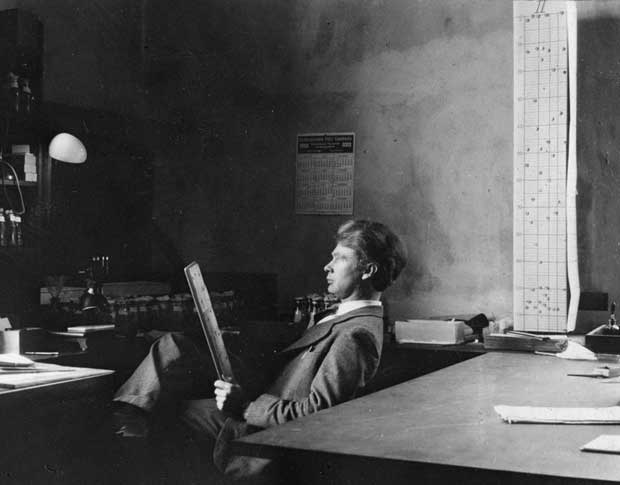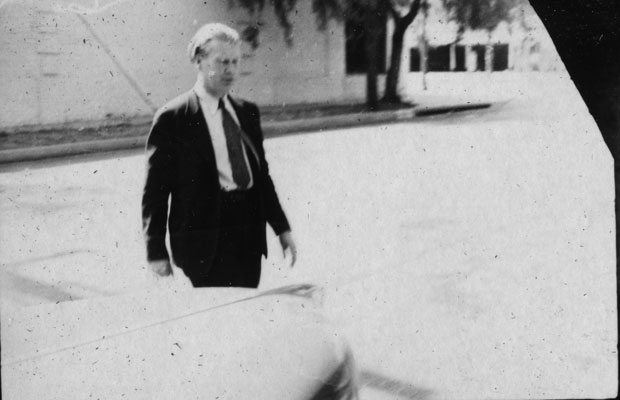Morgan’s Lab
← Edith Wallace drawings of gynandromorphs, flies that have both male and female characteristics. Plate 4 in The origin of gynandromorphs. Morgan TH, Bridges CB. 1919. Carnegie Inst. Wash. Publ., 278: 1–122. Courtesy of Cold Spring Harbor Laboratory Archives
There is an almost Rashomon-like aspect to the famous Fly Room at Columbia University in the early 1900s. Alfred Sturtevant described the atmosphere as “Arcadian” — “what mattered was to get ahead with the work” and there was “a give-and-take atmosphere in the fly room.” H.J. Muller worried his ideas were being “stolen,” and some accused him of having a “priority complex,” while others thought Morgan was a naturalist who did not totally understand the work of his students.
But it is clear that Morgan –“the Boss”– had assembled a remarkable group of investigators who changed the landscape of genetics research. Their work with the tiny fruit fly Drosophila melanogaster moved biological investigation from a descriptive to an experimental approach. Morgan began his work on Drosophila around 1907, intending to study evolution. He was probably introduced to this organism by Frank Lutz, who was at the Carnegie Institution of Washington Station at Cold Spring Harbor. Morgan worked virtually alone on this organism for the next few years and despaired that he might not make any progress — in January of 1910 he complained that “There’s two years work wasted.”
“we were in the right place at the right time.”
Morgan’s big breakthrough with Drosophila occurred early in 1910 when he discovered a white-eyed male fly. He bred this fly with a red-eyed virgin sister and got a Mendelian ratio of three red-eyed flies to one white-eyed fly in the F2 generation. He deduced that white eyes were a heritable character; to Morgan, this was a realization that the newly revived Mendelism was true. And only the males had white eyes, so he determined that the trait was sex-linked too. Other spontaneous mutations soon followed, encouraging Morgan to continue working with the fly. (Some have speculated that a transposon was responsible for this flurry of new mutations.)
Calvin Bridges entered Columbia University in 1909 as a member of the class of 1913, where he heard Morgan give the opening lectures in a Zoology course. As Sturtevant later recounted, “we were in the right place at the right time.” The next year, Bridges started work in the Fly Room in Schermerhorn Hall’s room 613, initially as a bottle washer, and Sturtevant (who ironically was color blind) was given desk space in the lab. Early on Calvin spotted a fly with vermilion eyes rather than the normal red, which impressed Morgan. Muller, who was an undergraduate at Columbia from 1906 to 1910, joined the Fly Room lab in 1912–1916 as a Ph.D. student. When Sturtevant produced a genetic linkage map of the Drosophila X chromosome in 1911 (published in 1913), the lab’s work swiftly changed to mapping all of the new genes Morgan’s “boys” were finding.
By 1913, Bridges had published his first paper on nondisjunction, which was an initial proof of the chromosome theory of heredity. He published a more detailed account of this relationship between genes and chromosomes as the first article in 1916 in the new journal Genetics – remarkably, this landmark paper was also his Ph.D. thesis. Morgan described these papers as “a striking visual demonstration of the chromosomal theory of heredity.” The following year, and for the rest of his life, Bridges received financial support from the Carnegie Institution of Washington.
Work proceeded quickly in the overheated atmosphere of the Fly Room. Curt Stern has described the rank smell of fermented bananas in the lab and the cockroaches that infested the lab as a result. And Morgan himself explained that “…our proximity to each other led to cooperation in everything that went on. The discovery of a new mutant was immediately announced and its location in the gene chain anxiously awaited.”
Bridges published the first Drosophila chromosome in 1916, the first chromosome deficiency in 1917, the second chromosome in 1919, chromosomal duplications and gynandromorphs in 1919, triploid and intersexes in the fly in 1921–1925, and the third chromosome and chromosomal translocations in 1923. And interspersed with the research were two influential books solidifying the chromosomal theory of heredity and the fly as a model organism – The Mechanisms of Mendelian Heredity in 1915 authored by Morgan, Bridges, Sturtevant, and Muller, and The Genetics of Drosophila in 1925 by Morgan, Bridges, and Sturtevant. Geneticist Elof Carlson describes Bridges’ contributions to classical genetics in this short essay. ↑
The free-spirited nature of the Fly Room prevailed and sometimes got its inhabitants into trouble of sorts. Alexander Weinstein recounted the adventure of the ostrich egg in which Morgan and his lab members cooked up an omelet from said egg — a specimen meant for E.B. Wilson, who was away when the egg arrived. And Morgan’s lab liked to play tricks on him too. Sturtevant described taking surreptitious photos of Morgan at work. “Bridges and I hid my camera in Bridges incubator, with a string attached, and got this shot without Morgan’s knowledge.”
Morgan moved his lab to Caltech in 1928 to become the Director of a new Division of Biology, and Sturtevant and Bridges went with him. Morgan focused on setting up the new department at Caltech, while Sturtevant and Bridges along with new lab members continued to dissect the genetics of Drosophila. Bridges had a lab on the second floor of Kerckhoff Hall.
The intellectual ferment of the Caltech lab is reflected in the caliber of people who passed through the lab. Future Nobelist George Beadle came to Caltech in 1931 and his reaction to Bridges reflects the regard in which Calvin was held by his colleagues. “I was almost overwhelmed at the thought of approaching such a distinguished geneticist, for I thought he would be so quick of mind that I would not be able to keep up my end of the discussion. It was with much amazement and relief that I discovered Bridges to be not only most friendly but quite slow and methodical in our discussion. He insisted on going over each point carefully and fully before going on to the next one.”
Another future Nobelist in the Morgan lab during the early 1930s was geneticist Barbara McClintock, the first female Fellow at Caltech. And yet another, physicist and nascent molecular biologist Max Delbrück, befriended Bridges when he came to Caltech in 1937 on a Rockefeller Foundation grant. Bridges described the intricacies of Drosophila genetics to Delbrück, but Delbrück decided that the bacteriophage was more suited to what he wanted to do. In his Caltech oral history of 1979, he said about Bridges that “I had never met a person so unpretentious, low key… I mean so intellectually unpretentious.” He described him as “really an outstanding scientist.”
The discovery of a technique for examining the large salivary gland chromosomes of the fly by two German investigators, E. Heitz and Hans Bauer, and the relationship of their structure to gene loci in 1933 by Theophilus Painter, a colleague of Muller’s at the University of Texas, opened the door to providing cytological proof that would augment the genetic proof Sturtevant and Bridges had already provided about the locations of genes. Bridges threw himself into this task with a vengeance — his keen eyesight and perfectionist nature made him a natural for this daunting task. By 1934 he described the polytene nature of these chromosomes and had soon mapped over 3500 bands. In the next few years, Calvin mapped thousands more and published initial cytological maps of the salivary gland chromosomes that remained the standard for decades.
Morgan was awarded the 1933 Nobel Prize in Physiology or Medicine “for his discoveries concerning the role played by the chromosomes in heredity.” Morgan could not attend the Nobel Award ceremony, but mindful of the contributions that Bridges and Sturtevant had made to this work, Morgan shared the Prize money with his, Bridges’, and Sturtevant’s children.

